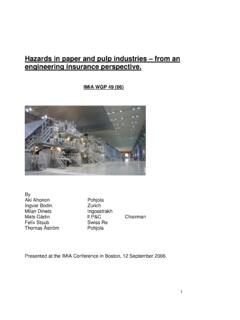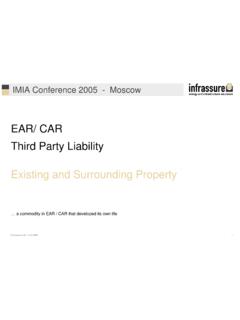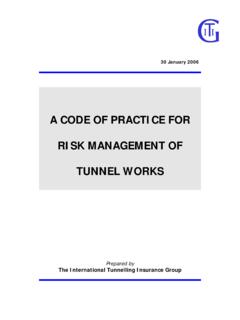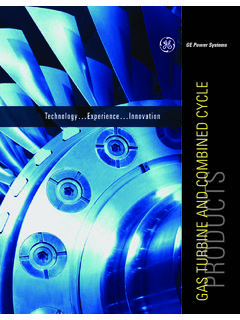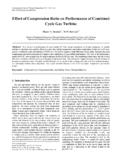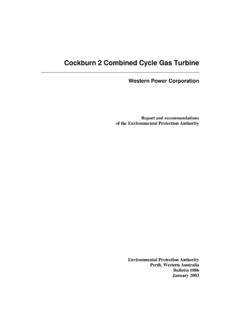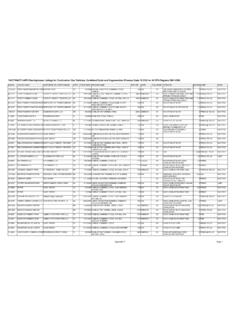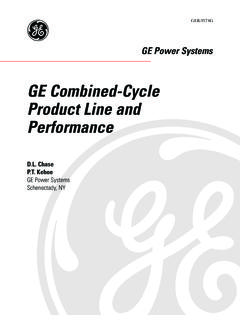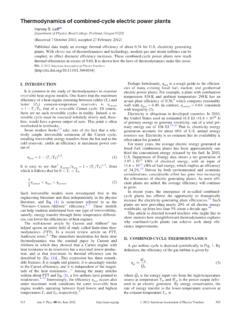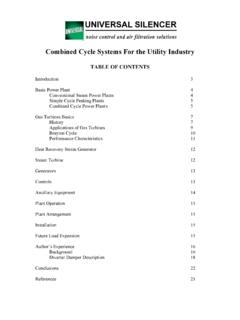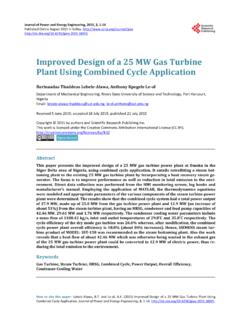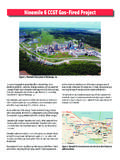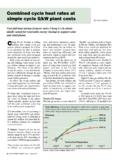Transcription of Combined Cycle Power Plants - I mia
1 IMIA Working Group Paper 91 (15) IMIA Annual Conference 2015, Merida (Yucat n), Mexico 26-30 September 2015 Combined Cycle Power Plants Working Group Members: Mamoon Alyah (Chairperson) Managing Director / Principle Engineer CEERISK Consulting Limited Jeff Ashman Risk Engineering & Technical Consultant Charles Taylor Adjusting Ali Arisoy Associate Director VHV Allgemeine Versicherung Edryn Astley Power Engineer ACE European Group Eric Herbst VP, Risk Engineering Manager Munich Re America Patrick Jennings Principal Engineer - Boilers HSB Alexey Gusev Engineering Underwriting SOGAZ Insurance Group Roman Emelyanov Head of Engineering Underwriting SOGAZs Insurance Group Richard Radevsky (Sponsor) Technical Director Charles Taylor Adjusting IMIA Workgroup 92(15) Combined Cycle Power Plants _____ Contents 1.
2 Executive Summary .. 4 2. Introduction .. 5 3. Development, Features and Future forecast .. 6 4. Advances in Modern Combined Cycle Power Plants : .. 7 5. CCP Technology .. 8 Main Components .. 8 Combustion turbine .. 8 Steam turbine .. 13 Heat Recovery Steam Generation System .. 16 CCPP Auxiliary Components .. 19 DIVERTER DAMPER AND BYPASS STACK SYSTEM .. 19 Plant cooling .. 19 CHEMICAL DOSING SYSTEM .. 21 WATER TREATMENT SYSTEM .. 21 SANITARY AND WASTEWATER TREATMENT SYSTEM .. 22 ELECTROCHLORINATION SYSTEM .. 22 SAMPLING SYSTEM .. 22 SHUTDOWN DIESEL GENERATOR .. 22 FIRE PROTECTION SYSTEM .. 22 VENTILATION AND AIR CONDITIONING SYSTEM .. 23 CONTINUOUS EMISSION MONITORING SYSTEM (CEMS) .. 23 Electrical connections .. 23 6. Underwriters Perspective & Challenges.
3 24 Surveys .. 24 Underwriting information .. 26 Location Considerations .. 30 Specific risks (earth quake, corrosion) .. 30 4. Operational Considerations: .. 31 Impact of Regulations, legislation and standards .. 31 Environment .. 31 Health & safety .. 32 Commercial Considerations .. 32 Operational Concerns of CCPP .. 33 5. Claims Examples .. 33 2 IMIA Workgroup 92(15) Combined Cycle Power Plants _____ 6. Summary & Conclusions .. 35 Appendix 1 Set of Abbreviations .. 37 Appendix 2: CCPP Risk Assessment Questions for Operating Power Accounts .. 39 Appendix 3: Typical Scope of Work for Conversion of Simple Cycle Gas turbine to CCPP .. 43 3 IMIA Workgroup 92(15) Combined Cycle Power Plants _____ 1. Executive Summary This IMIA paper examines the most significant risks associated with the construction (including conversion) and the operation of Combined Cycle Power Plants (CCPP).
4 The paper presents different technologies used in a CCPP, highlighting the main differences with simple Cycle Power Plants and emphasizing the benefits of the new Combined Cycle technology. The paper also lists some of the most relevant risks that exist during the construction and operation of the CCPP. This includes commissioning and testing risks as well as material failure and equipment breakdown risks. A special section is dedicated to the underwriting perspective of insuring a Combined Cycle Power plant. It provides the details and issues to consider when underwriting a Combined Cycle Power plant. The paper also provides special sections with contribution from a CCPP operator providing clients perspective especially with regard to risk profile and how regulations and standards impact the risk profile of a CCPP.
5 Though this perspective is mostly focused on the UK, it does lend itself very well to the operation of CCPP s in multiple locations worldwide. The paper is not intended to provide an in-depth discussion of the technologies used in various CCPP s of different configurations. Instead, the reader is encouraged to reference a number of previously published IMIA work papers on different technical topics. Though a tremendous effort was made to describe and discuss the technology of boilers used in a CCPP, we were unable to dedicate a special section on the topic of boilers (superheated or otherwise) due to limitation of resources and time. Instead, it is the recommendation of this working group that the topic of boilers be the subject of an independent working group in the near future.
6 4 IMIA Workgroup 92(15) Combined Cycle Power Plants _____ 2. Introduction The additions of modern CCPP s have allowed for the retirement of less efficient and higher air polluting oil and coal fired fossil Power Plants . CCPP s are the most efficient method of adding electrical capacity to areas with an abundance of natural gas, due to: A. Low capital cost, compared to conventional fossil Power Plants B. Shorter construction time compared to conventional fossil Power Plants : Combined Cycle Plants are manufactured as a standard reference plant with pre-engineered packages designed to plug together, minimizing onsite installation construction time. The major equipment such as the gas turbine (GT), steam turbine (ST) and generator step up (GSU) transformers are shipped to the site assembled and factory tested.
7 The Heat Recovery Steam Generators (HRSG) are shipped in factory manufactured modularized sections designed for easy tube welding and assembly. Modular construction with factory plug and play auxiliaries enable faster construction times with less human error vs, the traditional method of pulling cables and hardwiring auxiliaries in the field. This minimizes the installation time, cost and schedule risk. The typical erection time of a Combined Cycle Power plant is as short as 2 2 1/2 years. C. Low fuel cost, due to higher Cycle efficiency (lower cost per kilowatt) than conventional fossil Power Plants D. Lower emissions compared to conventional fossil Power Plants E. High efficiency and high Power density: A CCPP has a higher thermal efficiency than any other type of conventional Power Plants .
8 The energy efficiency of modern Combined Cycle Power Plants is in the range of 50 62%. The term Combined Cycle refers to the two thermodynamic cycles that are Combined for maximum efficiency. The Brayton combustion turbine topping cycle1 and the Rankine steam turbine bottoming cycle2. Diagram 1: The basic principles of operation of a typical CCPP 3 2 1 5 4 1 Brayton topping Cycle 2 Rankine bottoming Cycle 5 IMIA Workgroup 92(15) Combined Cycle Power Plants _____ Natural gas or liquid fuel is burned in the combustion turbine (1) creating a constant pressure which spins a generator (2) producing electricity. The combustion turbine exhaust waste heat and mass flow is captured in a heat recovery steam generator (3) that creates superheated steam to drive a steam turbine (4) that spins another generator (5).
9 Capturing the heat from the combustion turbine in a HRSG and steam turbine generator, produces approximately 50% more electricity from the natural gas than using the combustion turbine generator in simple Cycle mode alone. For insurer s the main pieces of capital equipment, that in the event of a loss can exceed the policy deductible, are the combustion turbine , the steam turbine , generator, HRSG, and Generator Step Up (GSU) transformer. The most common type of Combined Cycle Power plant utilizes gas turbines and is called a Combined Cycle gas turbine (CCGT) plant. Because gas turbines have low efficiency in simple Cycle operation, the output produced by the steam turbine accounts for about half of the CCGT plant output.
10 There are many different configurations for CCGT Power Plants , but typically each GT has its own associated HRSG, and multiple HRSGs supply steam to one or more steam turbines. For example, at a plant in a 2x1 configuration, two GT/HRSG trains supply to one steam turbine ; likewise there can be 1x1, 3x1 or 4x1 arrangements. The steam turbine is sized to the number and capacity of supplying GTs/HRSGs. 3. Development, Features and Future forecast The commercial development of steam and gas turbine Combined cycles has proceeded in parallel with gas turbine development. The first gas turbine installed in an electric utility in the United States was applied in a Combined Cycle . This was a MW gas turbine that used the energy from the exhaust gas to heat feedwater for a 35-MW conventional steam unit.


